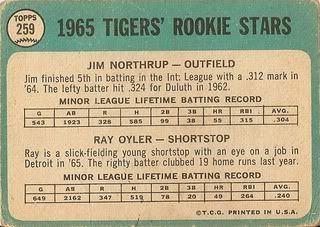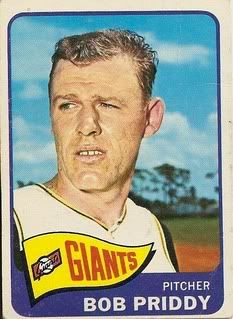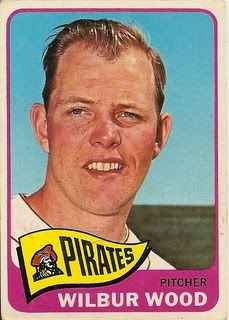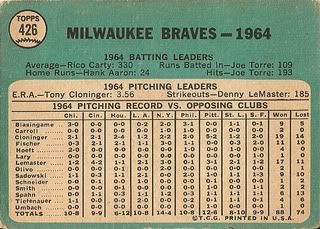
Pro tip: if you're going to airbrush a logo onto somebody's cap, make sure you're not placing the photo right next to a picture of someone wearing the real thing.
Fun facts about Jim Northrup:
-A native of Breckinridge, MI, Jim was a five-sport athlete at nearby Alma College (baseball, football, track, basketball, and golf). He turned down contract offers from the NFL's Bears and AFL's Titans (now the Jets) to sign with the Tigers in 1961.
-He debuted with the Tigers in late 1964, when he was 24 years old. His only hit in 12 at-bats was a double off of Milt Pappas.
-In 1966, Northrup got regular playing time and found his stroke, placing second on the team with 24 doubles while batting .265 with 16 home runs and 58 RBI.
-He was a big contributor to Detroit's World Championship season of 1968. His 153 hits, 29 doubles, and 90 RBI were all tops on the club, and he batted .264 (the team average was .235). Of his 21 home runs, 4 were grand slams; he became the first player ever to hit 3 in a single week.
-The outfielder saved his best for the 1968 World Series, slugging .536 and driving in 8 runs. His
Game 4 home run off of Bob Gibson accounted for the only run the Cardinals ace allowed in his first 24 innings in the series. A third-inning grand slam in
Game 6 fueled a 13-1 Detroit romp. Finally, his two-out, two-run triple off of Gibson in
Game 7 broke a scoreless tie in the seventh inning, setting the stage for a 4-1 Tigers victory in the clincher.
-Jim achieved several career highs in 1969: runs scored (79), doubles (31), home runs (25), and slugging percentage (.508). His .295 average was also a personal best at that juncture.
-On
August 28, 1969, he became the first Detroit player since Ty Cobb to go 6-for-6 in a game. The final two hits came in extra innings, with the capper a walk-off two-run homer that downed the A's 5-3.
-Billy Martin took over as Tiger manager in 1971, and the mercurial skipper feuded with Northrup. He pinch hit for the outfielder with the tying run on base in the deciding at-bat of 1972 ALCS (Northrup had hit .357 in the series), a move that did not pay off. The following year, Martin limited him to 119 games (his fewest since his rookie year) despite a .307 batting average.
-He was dealt from the Tigers to the Expos and the Expos to the Orioles in 1974, and finished his career the next year with a .273 average as a part-timer in Baltimore. In parts of 12 seasons he batted .267 with 153 home runs and 610 RBI.
-Jim and ex-Tigers teammate Norm Cash spent a few years playing for the Detroit Caesars, a professional slow-pitch softball team owned by future Tigers boss Mike Illitch. He provided color commentary on Tigers games from 1985 through 1994, and is now the CEO of Jim Northrup and Associates, a Michigan-based manufacturer's representative firm.
Fun facts about Ray Oyler:
-Ray was born in Indianapolis and served in the Marines before signing with the Tigers in 1960.
-After hitting .240 in five minor league seasons, he joined the Detroit club in 1965 at age 26.
-Oyler had a reputation as a talented defensive shortstop, and he would have had to have been. His major league batting averages by year: .186, .171, .207 (this was 1967, when his OPS+ was a career-best 60), .135, .165, .083.
-Believe it or not, Ray was a career .286 hitter (8-for-28) against Tommy John.
-The Seattle Pilots grabbed him with the fifth overall pick of the 1968 expansion draft. Inspired by local disc jockey Bob Hardwick, an excited throng of 15,000 Seattle fans joined the Ray Oyler "S.O.C. I.T. T.O. M.E. .300 Club." The mnemonic stood for "Slugger Oyler Can, In Time, Top Our Manager's Estimate". The club provided the shortstop with a car and apartment for the season, and celebrated with horns and confetti when he came to bat for the first time at home. He responded to this adoration with a go-ahead home run in
the following home game, one of seven he hit that year; his previous career total had been eight!
-Pilots teammate and
Ball Four author Jim Bouton asserted that Oyler's nickname was "Oil Can Harry", because "he always looks as though he had just changed a set of rings."
-His major league career ended with an ugly 24-game stint with the Angels in 1970. In parts of six seasons, he hit .175 with 15 home runs and 86 RBI.
-Ray was a player-coach for the AAA Salt Lake City Angels in 1971 and Hawaii Islanders in 1972.
-After retiring, Oyler settled in the Seattle area. He too played slow pitch softball for a time, and also worked for Safeway, a bowling alley, and Boeing.
-He died of a heart attack at age 42 in January 1981. Some think that a battle with alcoholism affected his career and shortened his life.










































